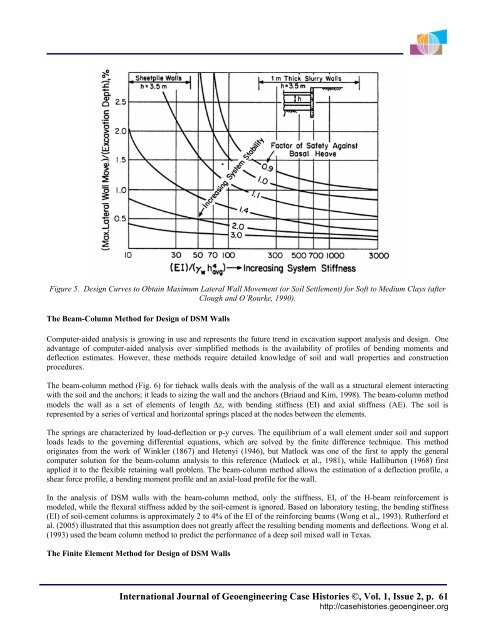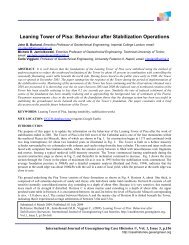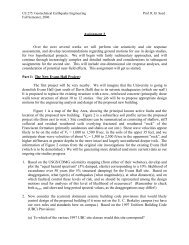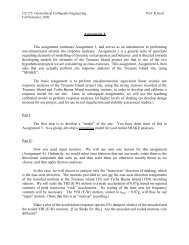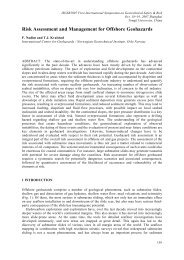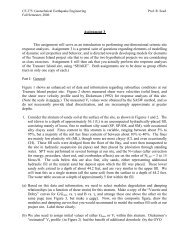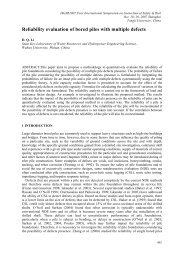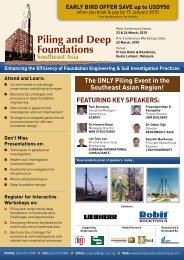Design Process of Deep Soil Mixed Walls for Excavation Support
Design Process of Deep Soil Mixed Walls for Excavation Support
Design Process of Deep Soil Mixed Walls for Excavation Support
Create successful ePaper yourself
Turn your PDF publications into a flip-book with our unique Google optimized e-Paper software.
Figure 5. <strong>Design</strong> Curves to Obtain Maximum Lateral Wall Movement (or <strong>Soil</strong> Settlement) <strong>for</strong> S<strong>of</strong>t to Medium Clays (after<br />
Clough and O’Rourke, 1990).<br />
The Beam-Column Method <strong>for</strong> <strong>Design</strong> <strong>of</strong> DSM <strong>Walls</strong><br />
Computer-aided analysis is growing in use and represents the future trend in excavation support analysis and design. One<br />
advantage <strong>of</strong> computer-aided analysis over simplified methods is the availability <strong>of</strong> pr<strong>of</strong>iles <strong>of</strong> bending moments and<br />
deflection estimates. However, these methods require detailed knowledge <strong>of</strong> soil and wall properties and construction<br />
procedures.<br />
The beam-column method (Fig. 6) <strong>for</strong> tieback walls deals with the analysis <strong>of</strong> the wall as a structural element interacting<br />
with the soil and the anchors; it leads to sizing the wall and the anchors (Briaud and Kim, 1998). The beam-column method<br />
models the wall as a set <strong>of</strong> elements <strong>of</strong> length Δz, with bending stiffness (EI) and axial stiffness (AE). The soil is<br />
represented by a series <strong>of</strong> vertical and horizontal springs placed at the nodes between the elements.<br />
The springs are characterized by load-deflection or p-y curves. The equilibrium <strong>of</strong> a wall element under soil and support<br />
loads leads to the governing differential equations, which are solved by the finite difference technique. This method<br />
originates from the work <strong>of</strong> Winkler (1867) and Hetenyi (1946), but Matlock was one <strong>of</strong> the first to apply the general<br />
computer solution <strong>for</strong> the beam-column analysis to this reference (Matlock et al., 1981), while Halliburton (1968) first<br />
applied it to the flexible retaining wall problem. The beam-column method allows the estimation <strong>of</strong> a deflection pr<strong>of</strong>ile, a<br />
shear <strong>for</strong>ce pr<strong>of</strong>ile, a bending moment pr<strong>of</strong>ile and an axial-load pr<strong>of</strong>ile <strong>for</strong> the wall.<br />
In the analysis <strong>of</strong> DSM walls with the beam-column method, only the stiffness, EI, <strong>of</strong> the H-beam rein<strong>for</strong>cement is<br />
modeled, while the flexural stiffness added by the soil-cement is ignored. Based on laboratory testing, the bending stiffness<br />
(EI) <strong>of</strong> soil-cement columns is approximately 2 to 4% <strong>of</strong> the EI <strong>of</strong> the rein<strong>for</strong>cing beams (Wong et al., 1993). Ruther<strong>for</strong>d et<br />
al. (2005) illustrated that this assumption does not greatly affect the resulting bending moments and deflections. Wong et al.<br />
(1993) used the beam column method to predict the per<strong>for</strong>mance <strong>of</strong> a deep soil mixed wall in Texas.<br />
The Finite Element Method <strong>for</strong> <strong>Design</strong> <strong>of</strong> DSM <strong>Walls</strong><br />
International Journal <strong>of</strong> Geoengineering Case Histories ©, Vol. 1, Issue 2, p. 61<br />
http://casehistories.geoengineer.org


